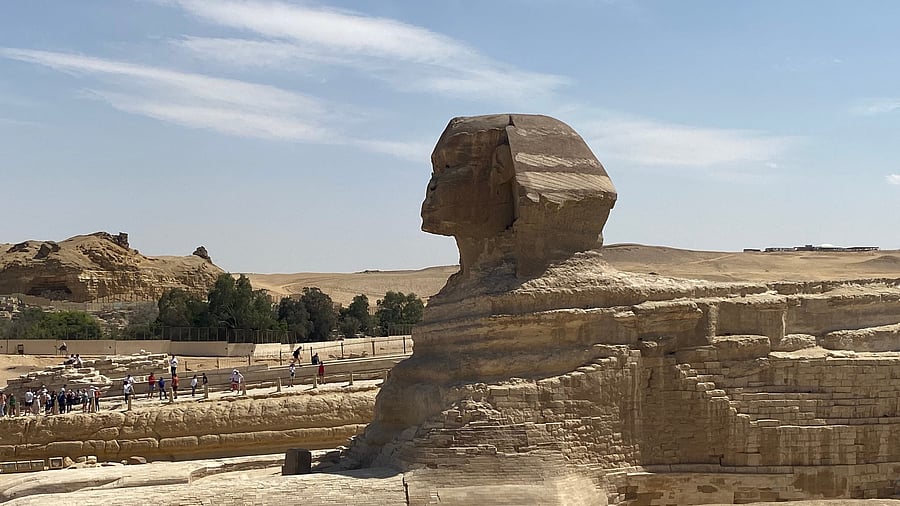
The Sphinx by the Pyramids of Giza in the desert of Egypt.
PHOTO BY AUTHOR
By Anvitha
Cairo, a city brushed by dust and steeped in history, offers a vivid glimpse into the past. Every corner tells a story, from the vintage cars of the ‘90s, now well past their prime, to the quiet streets where brave vendors hawk trinkets right in the middle of the road. And looming over it all are the ancient monuments — some 4,000 years old or more like the pyramids — standing as timeless witnesses to the city’s enduring legacy. These monuments outlast and outshine everything made in the last 40 years, perhaps even longer.
Unless you’re from a hotter region, the heat is a challenge you learn to endure. You have my respect if you can endure the heat, and as I sweat my way through it, I find myself standing before the Great Pyramids. Their limestone exteriors match the sand they sit upon, seamlessly blending in, so much so that it’s hard to distinguish where one ends and the other begins at the base. The top, however, stands in stark contrast — towering majestically over the endless sky. One can’t help but wonder if its vastness was designed to overshadow the heavens. I wouldn’t put it past the ancient Egyptians.
Everything here is larger than life — none more so than their obsession with the afterlife. The practice of mummification feels like one of the greatest scams of ancient times. The sheer scale, energy, time, and resources spent on this practice are mind-blowing. As I walk through some of the tombs in the Valley of the Kings and Queens, it becomes clear: Pharaohs spent the majority of their reign preparing for their inevitable death from the moment they ascended the throne. Planning and constructing tombs as soon as they began their rule might sound a little insane, but with good marketing and the right pitch, even the most outlandish ideas can take root. We now understand the kind of influence that can have. The tombs are expertly designed, with chambers and tunnels carved into the magnificent landscape of the Valley. The West Bank of Luxor, the ancient city of Thebes, home to these tombs, is a sight to behold. It’s easy to see why Thutmose I of the New Kingdom chose this as his final resting place. The Pharaoh did not spend the immense resources and time it would take to build pyramids, opting instead for a more sustainable — and still grand — solution.
Leaving Cairo behind, I head toward the desert region of Aswan. The dry heat here is something to respect. But hopping aboard a cruise along the Nile offers a more enjoyable way to navigate the intense heat while experiencing Egypt in all its glory. The Nile is now a tamer, safer river thanks to the High Dam, which keeps both the waters and crocodiles under control. As someone from the land of temples, I felt a deeper, more solitary connection to the now-ruined temples. These ancient structures remind us of a bygone era — of rich, magnificent cultures that have long since faded, leaving only remnants. And yet, the gods and goddesses once worshipped here are forgotten by all but the stones. The same could be said of many great civilisations — from the Greeks and Romans to the Mayans — and, closer to home, the Vijayanagara Empire in Hampi. In comparison, India has fared somewhat better, as many of our temples are still in active use today. As I walk among these temples, I’m in awe of their height. The towering columns and pillars dominate the space, commanding attention in a way that feels almost otherworldly. The concrete structures we build today are worlds apart from the ancient pillars of Karnak Temple, which remains my favourite. Each pillar ten times larger and taller. One detail that struck me was the remnants of paint. What little is left on the columns offers a glimpse into what the entire structure may have looked like in its prime — overwhelmingly beautiful and grand. How the paint has survived thousands of years in the harsh heat is beyond me. The techniques and scientific advancements behind such preservation are largely lost to time. As I reflect on all I’ve seen, the evening prayers echo along the Nile — a sound from a faith that is relatively new to these lands, compared to the many faiths that have come and gone. Yet, the old, original faith lingers, its presence in the land unshakeable, a quiet reminder that it once flourished in all its glory.
A repeated “Hello” snaps me back to the present, to the sun deck of our cruise. Along with the other guests who had been lazily lounging, I peer over the edge to see who’s calling out to us in the middle of the Nile. To our surprise, we spot two salesmen on a boat, skillfully tethered to our ship, trying to sell towels and bedsheets. As we watch, wondering how they plan to complete this transaction, they pull off a daring stunt: a towel, tightly rolled and sealed in a plastic bag, is tossed through the air and lands on our deck — four floors above! This land and its people, both old and new, have a way of transporting you — mind, body, and soul.